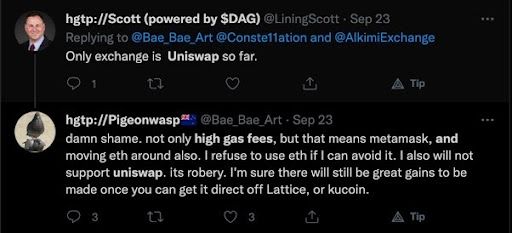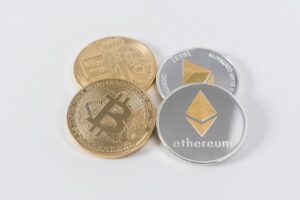
9/11 and the war on terror. Trump’s election. The rise of China. The digital revolution. Or possibly the GFC.
All these events had one thing in common — most experts didn’t see them coming. The political scientists were certain Clinton would become the first female president. The generals thought Afghanistan was winnable. The economists thought the housing bubble was ‘rock solid’.
The conventional wisdom, as expressed by Christian Bale in ‘The Big Short’, is “No one can see bubbles. That’s what makes it a bubble.”
What if I told you two academics found a way to spot financial bubbles? What if we could know if there is a crypto bubble?
In their forthcoming paper, ‘Inferring Financial Bubbles from Option Data’, Robert Jarrow (Cornell) and Simon Kwok (Sydney) provide an elegant method using option prices to identify financial bubbles in the market. In simplistic terms, they show option markets hold an assumption on the present value of the market. If this value differs heavily from the current market price, there could be a bubble.
Interestingly, Jarrow and Kwok show a trading strategy based on this method would have reaped returns of 3.6% p.a. above the market over the past 15–20 years.
So while ‘buying and holding’ the market is certainly simple and easy, it may not be the best.
Economists have never agreed on what a bubble really is, or if they even exist. Renowned Nobel Laureate Robert Shiller has pioneered research showing bubbles rarely burst, but mainly deflate and reflate around an asset’s true value. But that is for another article….
For this article, consider ‘bubbles’ to be short to medium-term price increases above the assets fundamental value.
Bitcoin is hovering at around $45k USD at the moment.
If you sit in the ‘Bitcoin’s going to six figures’ camp, maybe think about buying a call option. It’s a bit pricey, but it’ll give you the right to buy one Bitcoin in 1 year’s time at a fixed strike price of say $60k USD. The exercise date of the option is the day you can exercise (or use) the option.
Imagine you are right and at the exercise date in a year’s time Bitcoin trades at $100k USD. Then, your call option contract allows you to buy one Bitcoin for $60k USD. You can then immediately sell your Bitcoin for a $40k USD profit.
Now imagine Bitcoin instead plummeted to $20k USD. As the option owner, you also have the right to not buy Bitcoin at the strike price of $60k USD. You won’t lose any money except what you paid for the option contract in the first place.
If you think Bitcoin is ‘going to zero’, then maybe you should buy a put option. It will give you the right to sell one Bitcoin in the future at some strike price. If you’re correct and Bitcoin’s price plummets, then you’ll get some sweet profits.
Anyone who has seen ‘The Big Short’ will remember the opening scene. The camera pans over the archetypal American suburbia while Ryan Gosling narrates how
“These outsiders saw the giant lie at the heart of the economy, and they saw it by doing something the rest of the suckers never thought to do. They looked.”
Jarrow and Kwok give us a way to look.
Their thought process is elegant and simple. Options markets are effectively betting exchanges where the bet is on the future price of the underlying asset. From the current prices of call and put options at various strike prices, you can, with a little work, calculate a prediction of the future market price at the option’s exercise date.
Take the Bitcoin call option with a strike price of $100k USD as an example. If this call option is expensive to buy, the market is expecting Bitcoin’s price will go up. If it’s cheap, less people expect the price of Bitcoin to rise. Jarrow and Kwok use these option prices to calculate a prediction of what the market expects the future price to be.
You are then able to find the present value of these predictions. After considering all options, you can build a distribution for possible market prices.
They call this the state price distribution.
If the average of the state price distribution is lower than the current market price, it could indicate a mispricing.
For further explanation of the state price distribution see ‘A more detailed discussion’ at the end.
We can sum up the main results of the paper brilliantly in this initially daunting graph.
Anytime the thick blue line is completely above the x-axis there is a possible bubble in the S&P500. This is because the market price at that time was greater than the average of the state price distribution.
Now, look at the years where the dark blue line is above the axis.
We can see this method accurately predicted the dot com bubble and the GFC. This method can also show when growth in the S&P500 is ‘real’. If the orange line (the S&P500) is increasing and the thick blue line stays on the axis the growth is ‘real’ and not based on bubbling asset prices.
We have all heard the age-old investing advice ‘buy the index’. Charlie Munger (Warren Buffets right-hand man) is well known for his pithy quote,
“The big money is not in the buying or selling. It is in the waiting.”
Now there is no doubt Charlie is a smart guy, but looking out there at all the corporate raiders, short-sellers and quant genius’ it is a little hard to believe that’s where the big money really is.
The strategy Jarrow and Kwok developed for making 3.6% return above the buy and hold strategy is simple and lucrative: buy the asset early in its bubble and sell at the peak.
But how do you know where we are in the bubble?
Suppose the short term moving average of both the S&P500 and the dark blue line is greater than their respective long term moving averages. The bubble is in its infancy and has an upward trajectory, so the investor then buys and holds the asset.
When either of the short term moving averages falls below the long term moving averages the bubble is near or at its peak. The investor then sells the asset and deposits the proceeds into the bank prior to the bubble bursting or deflating. In time the entire process will begin again, where the investor buys the asset in the bubble infancy.
There isn’t any shorting, leveraging or options trading in this strategy at all.
In fact, when we spoke with Simon Kwok he said his paper “was not trying to find the best trading strategy”. His aim was to show bubbles “illustrate a level of predictability” and that this predictability can be clearly seen through options data.
If you were looking to find the best trading strategy — how much could you beat the market by?
So, there you have it. In the words of Ryan Gosling, Jarrow and Kwok have provided us with ‘the ability to look’.
Bubbles can threaten portfolios — you’d know this if you are older than 30. Thanks to this academic research, you can see financial bubbles forming in real-time and also use a simple, low-risk strategy to beat the market.
If you wanted to be a little more ambitious you could use the same technique on riskier assets like commodities or even cryptocurrency. The strategies work just the same, and in a more volatile market could make an even greater payoff.
Though there is a greater benefit. When we spoke to Kwok he argued,
“Policy makers like those in reserve banks can use this methodology to make macroeconomic shifts or issue warnings, to prevent bubbles that could negatively affect the general public.”
Imagine how useful this would have been 15 years ago! The thought that the pain, stress and suffering felt worldwide after the GFC could have been at least partially averted is sobering.
There is a chance Jarrow and Kwok have saved a whole lot of people in the future, the pain of another GFC…
We will leave you with one final thought. You have now heard the saying, “No one can see bubbles. That’s what makes it a bubble”. But if all of us can see the bubble, is there really a bubble there at all?
- 7
- advice
- All
- American
- around
- article
- asset
- Assets
- Bank
- Banks
- BEST
- Betting
- Bit
- Bitcoin
- bubble
- build
- buy
- buy bitcoin
- Buying
- call
- China
- coming
- Commodities
- Common
- contract
- crypto
- cryptocurrency
- Current
- DA
- data
- day
- digital
- Early
- economy
- Election
- events
- Exchanges
- Exercise
- expects
- experts
- Fe
- financial
- First
- future
- General
- Growth
- hold
- housing
- How
- How To
- HP
- hr
- HTTPS
- ia
- identify
- interest
- investing
- investor
- IT
- Level
- Line
- Long
- looked
- Making
- man
- Market
- Markets
- medium
- money
- months
- Near
- Option
- Options
- owner
- Pain
- Paper
- People
- prediction
- Predictions
- present
- president
- price
- Profit
- public
- Quant
- real-time
- research
- REST
- Results
- returns
- ROBERT
- scientists
- sell
- Short
- Shorting
- Simple
- SIX
- smart
- So
- Spot
- State
- Strategy
- stress
- sweet
- sydney
- The Future
- The Graph
- time
- trades
- Trading
- us
- USD
- value
- war
- warren
- WHO
- words
- Work
- worldwide
- year
- years













